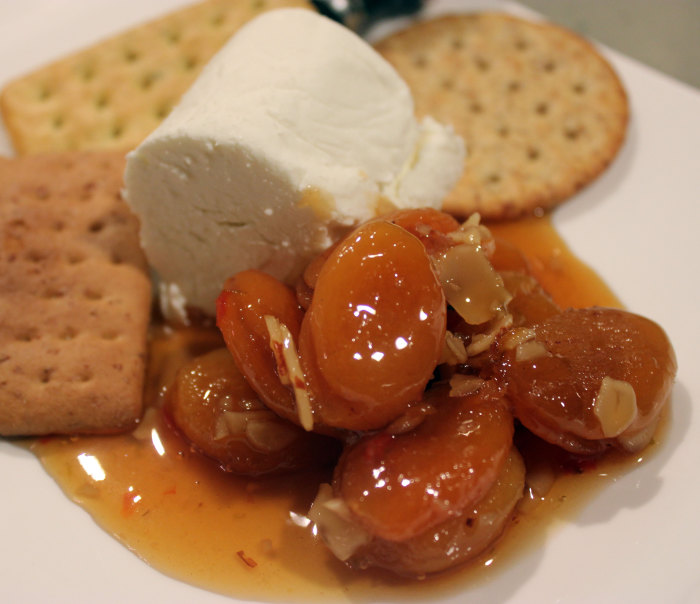For each of her corporate events — where teams come into our kitchen to cook together — Suzen loves for her guests to begin enjoying food from their first steps. So, as soon as the coats are off, guests are welcomed with appetizers.
We serve a very, very wide range of appetizer dishes but one has become dominant: goat cheese with crackers and with something sweet to add on top. That “something” has been honey, and the combination of a great honey and superior goat cheese is something you will adore if you have not yet been sticky. It’s impossible to eat this dish and not lick your fingers.
It’s not that I was bored with honey, it’s just that I found this recipe in the spicy Red Hot Chile Sauce Book by Dan May. Dan’s book is tour of world, continent by continent, showing how recipes evolved as peppers spread from their origin in Northern Mexico to remarkably wide use in every culture around the planet.
I don’t think Thailand would have been as interesting to visit, for example, before the post-Columbus chili culture evolved.
This particular recipe is from North Africa and is a typical — but taste wise exceptional — dish from that region. Fruit and chili are combined to give a sweet, hot condiment with a thousand uses. This goo is called a “jam” but I can think of it equally as sauce or spread. Or even goo. There is nothing wrong with goo, as long as it tastes sweet and hot. Use with crackers, or adorn roasted chicken, or even incorporate into a salad dressing.
The recipe below has instructions for testing when the jam has cooked. Suzen and I are good at a lot of things, but getting jam cooked to perfection is not one of them. Our attempt here was decent, because we used something called the Internet and we did something called “googling” to find that the set point for a cooked jam is 220°F. So, no testing with the back of a spoon, or drops into water, or any of those other frustrating ideas — the spoon things take time and the jam is still cooking so you can go way over the set point, as we have discovered more than once.
Finally, a word on North Africa. At the close of the last Ice Age, as vegetation returned, there was no Sahara dessert. That entire region was grassland, punctuated with flowing rivers and lakes as big as the Great Lakes. It was verdant and fertile. Perhaps around 3000BC, the climate began to change — not because of auto emissions. That grassland had been populated by wildlife and people. The people were forced to migrate, many of them congregating back along the one river that remained: the Nile. Egyptian society was the result.
The once verdant area shrunk, so that only the coastline along the Mediterranean was good for sustainable farming, which could exist for perhaps 10-20 miles inland. That thin belt was an agrarian powerhouse for the Roman Empire. Fruits, vegetables, wheat and wine were produced and sailed back to Rome. The roots of contemporary Middle Eastern or Mediterranean cuisine began then.
Then Christopher Columbus enabled the introduction of tomatoes and chilies and other foods that now seem “essential” to the Mediterranean diet. The climate keeps changing. The Sahara keeps enlarging to the south. And the people on the shores of the Mediterranean keep adapting as people have for thousands of years.
Cardamom-Infused Apricot and Almond Chili Jam
Yield: around 4 cups
Ingredients:
- 3 ¾ cups ready-to-eat dried apricots
- 2 cups packed muscovado sugar
- ¾ cup almonds, roughly chopped
- ½ cup lemon juice zest
- Juice of 1 lime
- ¼ teaspoon ground cardamom
- ½ small Habanero chili, deseeded and finely chopped
- 1 large red chili, such as a Guindilla, as long as it is fleshy and not too hot, deseeded and finely chopped
Preparation:
Put the apricots in a bowl and add 2 ½ cups water, then leave overnight to soften and rehydrate. Tip the soaked apricots and their soaking water into a large saucepan and bring to the boil, then gently simmer for 30-40 minutes until they are soft. Stir in the sugar and heat over a low heat to dissolve, stirring constantly to ensure no sugar catches on the base of the pan. Once you are sure that all the sugar has been dissolved, turn the heat up. Add the almonds, lemon juice, lime zest and juice, cardamom and chilies. Boil rapidly over high heat, stirring regularly, to prevent the contents sticking to the base of the pan.
To test if the jam has reached setting point, drip a little onto a saucer and chill briefly in the fridge, or preferably in the freezer. If it forms a skin, it is ready. If not, return to the heat, continue cooking and test again in 10 minutes. Pour into sterilized jars and seal.
Source: Red Hot Chili Sauce by Dan May[Ryland Peters & Small, 2013]
Photo Information: Canon T2i, EFS 60mm Macro Lens, F/4.5 for1/50th second at ISO 800

